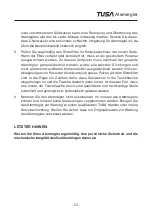
- 8 -
Regulators
EN
be caused by incorrect mounting of the regulator on the tank valve, or by a
damaged O-ring in the tank valve.
10. To confirm that the regulator delivers air properly, first exhale through the
mouthpiece to blow any foreign matter out of the second stage, then inhale. A
few of these breathing cycles should immediately indicate proper function.
11. If you are using the second stage as an Octopus regulator, it is strongly
recommended to utilize an Octopus plug to prevent any foreign matter from
entering the second stage through the mouthpiece.
12. When the second stage is not in your mouth, uncontrolled air delivery can
take place. This can be stopped by turning the second stage upside down and
allowing it to fill with water. Should the air delivery continue, abort the dive and
have the regulator inspected by a TUSA Authorized Service Center.
SECTION IV
AFTER DIVE PROCEDURES
Providing the best possible preventative and routine maintenance before, after, and
between dives will help to ensure the maximum life of your TUSA Regulator. To
achieve this goal, there are a number of simple, yet important, routine maintenance
procedures that should be followed by the diver after each use of the equipment. The
following procedures should be diligently followed in order to obtain the maximum
life and serviceability from your regulator.
1. After each day of diving, the regulator must be cleaned, inspected, and prepared
for the next use, or for storage. As soon as the regulator is removed from the air
cylinder, reinstall the dust cap over the regulator inlet port. This cap is normally
attached to the First Stage and therefore has been under water. Be sure to dry
all the water out of this cap before securing it over the inlet port. Ensure that the
O-ring, if fitted, is in place inside the dust cap.
2. As soon as possible after diving, the regulator should be soaked in warm, not
over 50°C (122°F) water to remove salt and mineral deposits. The preferred
method is to attach the regulator to a charged air cylinder, open the cylinder
valve, and thoroughly soak both the first and second stage regulators . Pay
particular attention to directing water into the mainspring cavity of the first stage
regulator, the second stage mouthpiece, and the holes in the second stage
cover. Depress the purge button several times while the regulator is submerged
in water. Dry the regulator by pressing on the purge button with the mouthpiece
pointing down. Place the dust cap in position in the yoke, or over the DIN screw.










































